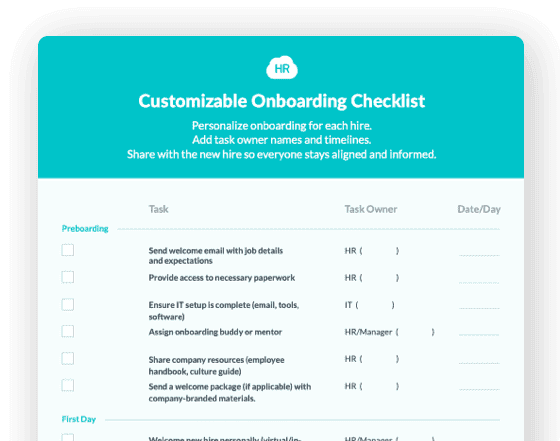

 Cut onboarding time
by 60%—here's the
Ultimate Checklist
that helped do it.
Cut onboarding time
by 60%—here's the
Ultimate Checklist
that helped do it.

For an organization to cater to diverse business processes may be quite a challenge. Business process management is vital for your business regardless of its size. This article will walk you through all the information you need to know about managing your business processes using automation.
What Is Business Process Management?
Business Process Management is the way a company assesses, creates, or edits foreseeable processes that seek to establish the core of its business.
Every department may cater to several or more core processes. The departments are responsible for transforming data or raw material into useful information.
It is an organizational discipline allowing a company to perceive all of the processes individually and overall. The process realizes the current state of the business, thereby identifying areas that can be improved, creating an effective organization that operates efficiently.

Importance of Business Process Management
Living in an era where technology continues to evolve, business owners are constantly challenged to resist market pressure and remain competitive while cutting costs and raising productivity levels by improving business processes.
To overcome these challenges, a lot of companies are in search of business process management software tools that can provide benefits, such as improved customer experience, better service, and product innovation, and more.
It is important as it gives project managers a competitive edge over other companies by helping leaders enhance the performance of the organization through different controls of the business processes. Business Processes are also convenient for CEOs and managers, as it allows them to control, respond, and apply appropriate IT solutions over operational activity.
Implementing a solid business process solution in your company can help you overcome several challenges and capitalize on opportunities accordingly, which ultimately leads to inevitable growth for the business.
Auditing and Operations Administrator of Medlinks Cost Containment, Inc. and Medlinks Staffing, LLC.
“I can’t say this enough: Without HR Cloud, we could not have communicated important project information or demonstrated that we could take on an increased workload. We now provide real-time workforce statistics and productivity reports that have helped us win more projects.”
How Does Business Process Management Improve efficiency?
Business Process Management solutions establish proper networking and functioning of tasks, by improving the performance of staff by updating the workforce tasks automatically instead of manually (as it would have been if it were not for BPM).
Implementing BPM for your organization would mean you can easily decrease your costs while your productivity rises. Some of the benefits it may include are the ability of the process to function under favorable conditions, adjusting them to establish high performance, and following controls to analyze the future output of these processes.
The level of productivity enhances after the implementation of automatic manual tasks and getting rid of redundancies to lower the possible risk of errors or rework.
With the increase of pressure that businesses have to go through to enhance their business process management strategy, the importance of the software will seemingly increase simultaneously.
Added transparency of business process management assists in making adjustments that maximize productivity and profitability, helps in monitoring processes while setting a company’s objectives alongside business processes.
 Ready to pass your next audit—without the stress? See how you can simplify compliance and eliminate gaps before they become problems.
Ready to pass your next audit—without the stress? See how you can simplify compliance and eliminate gaps before they become problems.


What Is the Importance of Creating Business Process Models?
A well-established business process model could consist of one or multiple business processes. These processes illustrate methods of operations that are being carried out to the side with the intended goals of a company.
To model business processes effectively, a company must communicate and document the business processes. Process modeling offers a standard method and unified language to communicate the processes and information about the rules and processes. It is often in the form of a graphical representation of a company’s workflows to identify any room for improvement and is achievable with several techniques.

Benefits of Modeling
Improves Efficiency: Proper implementation of business processes allows companies to see a significant decline in their cost with rising levels of productivity. Constant assessment of the processes can lead to high performance and efficiency.
Enforces Best Practices and Standardizations: Organizations will have to go through a set framework to achieve their goals, which they can revisit and amend according to the challenges and opportunities they come across.
Process Agility: With BPM software business processes can be more agile with a structure that needs constant documentation of the methods and steps in a process. The knowledge organizations receive from this allows them to realize the impact of changes in their business processes.
Transparency: BPM makes use of complicated software programs that evaluate business performance, automate processes, and unveil information on the business process’s operations and well-being in real-time. The increase in visibility allows the management to understand, modify the framework of processes, and track the outcome.
Competitive Advantage
Companies have a competitive edge over one another with an increase in service and product innovation by implementing business processes that may help to reduce costs without compromising on production.
Techniques
Process Flow Charts: Represents a sequence of activities but does not elaborate or break down on each of the business activities.
Data Flow Diagrams: Organizes data in its raw form, illustrating the flow of information in-between places.
Business Process Model and Notation (BPMN): Standard or graphical set objects that are used to illustrate the business process and interpret the links between the objects.
Steps to Business Process Modeling
-
Communication and inform the company of a business process model in the making
-
Establish a business process office
-
Define the company’s value-added chain
-
Link cooperative strategy to the business processes
-
Set objectives for the business processes
-
Draw out the AS-IS processes
-
Evaluate and identify the processes
-
Look into the potential of the business with the business process model and it’s set objectives
-
Implement and remain consistent with the new business process mode
-
Update the process constantly to achieve the best results
Conclusion
Business Process Model may seem like a lengthy framework for your company, but it might as well be a necessity in the near future. It is best to establish one now and attain the most out of the benefits for your management and company to get used to the processes and the way they are tackled so your organization is met with inevitable prosperity.
About Author: This article is written by a marketing team member at HR Cloud. HR Cloud is a leading provider of proven HR solutions, including recruiting, onboarding, employee communications & engagement, and rewards & recognition. Our user-friendly software increases employee productivity, delivers time and cost savings, and minimizes compliance risk.
 Discover how our HR solutions streamline onboarding, boost employee engagement, and simplify HR management
Discover how our HR solutions streamline onboarding, boost employee engagement, and simplify HR management
Keep Reading
Top 10 Healthcare HR Challenges That Right HR Platform Can Solve
Healthcare HR teams in 2025 face mounting pressure. A 2025 NSI survey found average
The Ultimate Guide to Choosing the Best Performance Management Software in 2025 (and Why HR Cloud Stands Out)
Performance management software has evolved from simple annual review tools to
Performance Management Software for Schools: Run Automated Review Cycles and Never Lose a Record Again
Ever feel like teacher evaluations are a full-time job in themselves? Juggling 10- and
Like What You Hear?
We'd love to chat with you more about how HR Cloud® can support your business's HR needs. Book Your Free Demo

Build a Culture of Recognition. Boost Engagement. Guaranteed.
Workmates empowers employees to stay informed, connected, and appreciated—whether they’re on the front line, in the office, or remote. Recognition drives 12x higher engagement.Trusted by industry leaders in every sector




Cut Onboarding Costs by 60%.
Take the confusion and follow-ups out of onboarding with automated workflows, digital forms, and structured portals—so new hires ramp faster 3X quicker.Trusted by industry leaders in every sector





